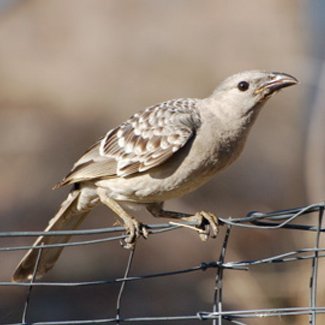Male bowerbirds stick to their own style

WHEN IT COMES TO attracting a mate, great bowerbirds have unique patterns of seduction.
However, new research has revealed that males will revert to their individual style to attract a mate, even when presented with a more effective alternative.
Seduction rituals of the great bowerbird
To lure the opposite sex, male great bowerbirds (Ptilonorhynchus nuchalis) construct elaborate bowers, which are tunnels made of densely thatched sticks. These have courts at each end, where they arrange hundreds of dull-coloured objects such as stones, bones and bleached shells in complex patterns. Small objects are positioned close to the tunnel, while larger objects are positioned further away.
When a female enters the bower, the male stands on the court and displays other brightly coloured ornaments to her while exhibiting his purple and turquoise nuchal crest (the feathers that fan out from the back of his neck).
From inside the tunnel, the female witnesses a visual illusion as she looks out over the court during the male’s performance: the configuration of dull-coloured objects induces an altered perspective for her and she sees a much more even pattern than she would if the objects were arranged at random.
The quality of this illusion affects the likelihood of her choosing to mate with the male – the better the illusion, the higher the chance of mating success.
The research has revealed that males consistently stick to their own preferred patterns, even if they have the ability and materials to improve upon them. “It’s a puzzling but very interesting result,” says study author Professor John Endler, at Deakin University in Victoria.
Male bowerbirds revert to individual methods

The tunnel of a male bowerbird. (Photo: Laura Kelley/John Endle)
The study, which was published in the Proceedings of the National Academy of Sciences last week, shows that male great bowerbirds have their own distinct styles for decorating their courts. Even if researchers produce better patterns for them, or provide the materials required to improve their designs, the birds consistently revert to their original configurations.
John and his Deakin co-worker, Dr Laura Kelly, altered the patterns on the courts of 25 different bowers. In doing so, they created better illusions, which would have been more attractive to females. Within three days, however, each male had repositioned the objects to their original formations.
“Birds with better gradients, or better visual illusions, receive more matings, so you’d think they would have taken advantage of accidentally having a good one,” John says. “However the birds put the gradients back to their previous, inferior values within a few days.”
The reason for this behaviour is unknown, however John speculates they may possess a mental template for how the pattern should look.
“It’s possible that they have their own template, or perception, for what an even pattern looks like,” he says. “If the male has a poor notion of what an even pattern is, then of course he’s going to reduce the quality back down to his previous value.”
Mating behaviour could hold clues to other species
Many species use physical displays to demonstrate male quality and stimulate the female’s sensory system, but John’s research suggests visual trickery can help to hold the female’s attention for longer.
“One thing this suggests is that illusions and other visual tricks might be important for any species, not just birds,” John says. “Anything the male can do to hold the female’s attention longer may make it more likely that she will mate with him, either because she simply looks at him for a longer period of time… or because she’s more stimulated by looking at him.”
Professor Rob Magrath, from the Australian National University in Canberra, agrees. He says this study raises many questions about how other species could use visual signals to lure mates.
“This is a fascinating study,” he says, commenting that it is particularly interesting that males resorted back to their own designs, rather than trying to lure females with better geometric patterns that were not their own.
“The results raise questions about why males are consistent and apparently ‘honest’, and will prompt research on other species,” Rob says. “Such research should give new insights into how signals are kept honest, which is a central question in animal communication.”
RELATED STORIES

